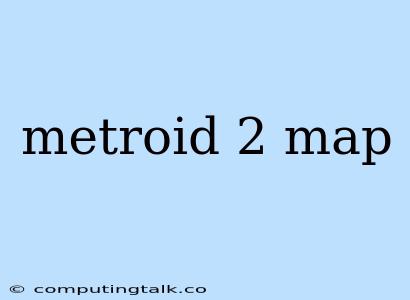Exploring the Depths of Zebes: A Look at the Map of Metroid II: Return of Samus
Metroid II: Return of Samus, the Game Boy installment in the beloved Metroid series, is known for its darker atmosphere and focus on the hunt for the Metroid. The game features a unique, non-linear level design that encourages exploration and experimentation. While the game's map may seem simple at first glance, it holds a depth and complexity that makes it a truly rewarding experience to navigate.
What Makes the Map of Metroid II Unique?
The map of Metroid II deviates from the more open-ended, interconnected maps of its predecessors. Instead, it presents a series of distinct, isolated areas, each with its own challenges and secrets. This structure, while different, still offers the player the freedom to choose their path and discover new areas at their own pace.
How to Approach the Map:
-
Start with the Basics: Begin your exploration with the Metroid you encounter early in the game. This creature's presence acts as a signpost, pointing you towards the direction you need to head. As you progress, new creatures will appear, further guiding you towards the next step in your journey.
-
Pay Attention to the Terrain: The game's map is rich in environmental details. Pay attention to the different textures, colors, and structures of the landscape. These elements often hint at the presence of hidden passages, power-ups, or even new enemies.
-
Utilize Your Abilities: The game's power-ups play a crucial role in navigating the map. The Morph Ball, the ability to access small spaces, is essential for exploring hidden areas. The Missile allows you to destroy certain obstacles, opening up new paths.
-
Don't Be Afraid to Backtrack: Backtracking is an essential part of exploring the map. Sometimes, you'll need to revisit areas you've already explored, using new abilities or knowledge to access previously unreachable sections.
Key Locations to Explore:
-
The Chozo Ruins: This area is essential to your journey. Explore it thoroughly, uncovering its secrets and collecting the Missile and Super Missile, crucial tools for your exploration.
-
The Main Caves: These vast caverns hold the remaining Metroid. Keep an eye out for specific patterns in the rock formations and walls. These patterns often indicate hidden passages and items.
-
The Tourian: This final area houses the Metroid Queen and the final challenge in your journey. This area requires careful exploration and understanding of the map's intricacies.
The Map's Impact on the Gameplay:
The map of Metroid II is more than just a visual representation of the game's world. It directly influences the game's gameplay, encouraging exploration, strategy, and a sense of discovery.
-
Non-Linear Gameplay: The map's design allows players to choose their own paths, fostering a sense of exploration and freedom. Players are not forced to follow a linear progression, making the game more engaging and replayable.
-
Strategic Approach: The map's complexity encourages players to think strategically about their movements and actions. Each step is a calculated decision, requiring careful consideration of the available paths, potential hazards, and available power-ups.
-
Sense of Discovery: The map's design rewards exploration and discovery. Hidden passages, secret items, and unexpected encounters add a layer of mystery and intrigue to the game.
Beyond the Game:
The map of Metroid II has resonated with players for decades, inspiring fans to create detailed maps and guides. These fan-made resources offer a deeper understanding of the game's world and its intricate design.
Conclusion:
The map of Metroid II: Return of Samus is a testament to the game's unique design. It's a complex and rewarding environment that challenges players to explore, strategize, and discover its secrets. This approach to map design continues to influence the Metroid series, shaping the exploration and discovery that define the franchise.
The map of Metroid II is not just a visual representation; it's a driving force behind the game's gameplay, encouraging exploration, strategy, and a sense of discovery.
